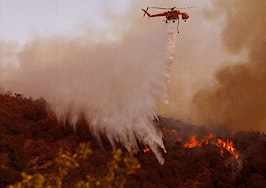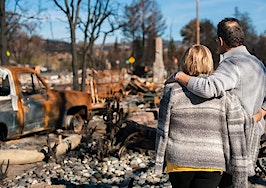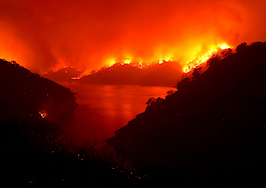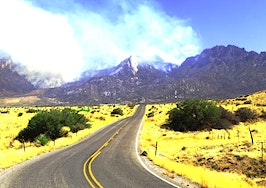As if rising home prices and mortgage rates aren’t creating enough worries for homebuyers, a new report estimates that one in 10 U.S. homes — roughly 14.5 million properties — were subjected to hurricane, wildfire, winter storm or severe weather events last year that caused $56.9 billion in property damage.
That’s according to property information and analytics provider CoreLogic’s 2021 “Climate Change Catastrophe Report,” which provides insights for homeowners, mortgage lenders and insurers on assessing and mitigating risks.
“While risk comes in various degrees, any sort of property damage can have a compounding effect on the homeowner and economic stability,” CoreLogic said in a statement released with the report.
With extreme weather events on the rise, homeowners, mortgage lenders and insurers need to be aware of the potential for natural disasters and their consequences, the report said. These include not only property loss and damage, but also long-term community impacts.
In hard-hit areas, homeowners are already contending with rising insurance rates and repair and reconstruction costs. In California, for example, premiums collected by insurers to provide fire and homeowners insurance increased by 27 percent from 2017 to 2020, to $11.1 billion.
A report funded by the Mortgage Bankers Association last year warned of the potential for increasingly devastating storms, excessive heat and wildfires, and drought that would stretch the National Flood Insurance Program to the breaking point, undermine home prices in vulnerable communities and drive more homeowners to default on their mortgages.
Climate change “poses a serious threat to the U.S. housing finance system,” Federal Housing Finance Agency chief Sandra Thompson said last month, when putting mortgage giants Fannie Mae and Freddie Mac on notice that they will be expected to factor the financial risks posed by climate change into their decision making.
CoreLogic’s hazard risk solutions include flood, wind and wildfire risk scores for individual properties that can help lenders and insurers make better-informed decisions.
Rival property data provider ATTOM provides risk assessments sourced from ClimateCheck for every U.S. property, measuring their current and future exposure to climate-change-related hazards including wildfires, floods and drought.
Last year was the third-costliest year on record for extreme weather events, according to an annual report from the National Oceanic and Atmospheric Administration.
The CoreLogic Climate Change Catastrophe Report broke down estimated property damage caused by four types of events last year:
- Wildfires: $1.46 billion in damage to 4,101 homes
- Severe weather, including tornadoes and hailstorms: $7.46 billion in damage to 563,627 homes
- Hurricanes: $33 billion in damage to 1.23 million homes
- Winter storms: $15 billion in damage to 12.76 million homes
In addition to the direct costs borne by homeowners and insurers, natural catastrophes “often leave communities with significant long-term impacts,” and recovery can continue “long after rebuilding is complete,” the report noted.
“A significant portion of the population may not wait for physical infrastructure to be rebuilt, instead choosing to relocate. This can leave the area with less human capital available to sustain its local economy,” the report said. “In addition, job displacement and the destruction of real estate assets can leave many community members unable to pay their mortgages or afford reconstruction costs. This is especially true in low-income areas, where underinsurance rates are high, and savings rates are low.”
After Hurricane Ida made landfall in Houma, Louisiana, in August, mortgage delinquency rates nearly doubled, from 7.4 percent before the storm to 13.5 percent by October, the report said.
Change in residential construction costs

Source: 2021 CoreLogic Climate Change Catastrophe Report.
Thanks to the pandemic, reconstruction costs are “meaningfully higher” than they were two years ago, although costs “leveled out between June 2021 and September 2021 as supply chains normalized after a year of disruption,” the report noted.
The report advised multiple stakeholders to take action to improve resilience from natural disasters, including:
- Mortgage servicers: Can implement more sophisticated risk assessment tools and borrower education programs to encourage proactive hazard mitigation
- Local, state and federal governments: Can enact policies informed by the latest research on natural catastrophes and their nuanced impacts on a local environment
- Insurers: Should take advantage of available data and analytics to improve underwriting accuracy, claims management efficiency and homeowner education
Homebuyers can also find information about the risk of flooding and other natural hazards on many property search sites, thanks to providers like climate risk data nonprofit First Street Foundation. A recent survey by Realtor.com found 78 percent of buyers consider natural disaster risk when house hunting.
An analysis by the First Street Foundation last year projected that average annual dollar losses due to flooding will increase 61 percent by 2051, to nearly $32.2 billion, and that rates on National Flood Insurance Program policies would have to be increased by 4.5 times if all properties at risk were insured.
Get Inman’s Extra Credit Newsletter delivered right to your inbox. A weekly roundup of all the biggest news in the world of mortgages and closings delivered every Wednesday. Click here to subscribe.







